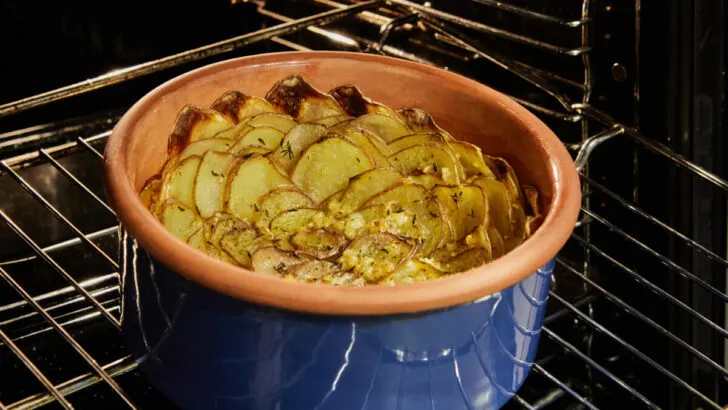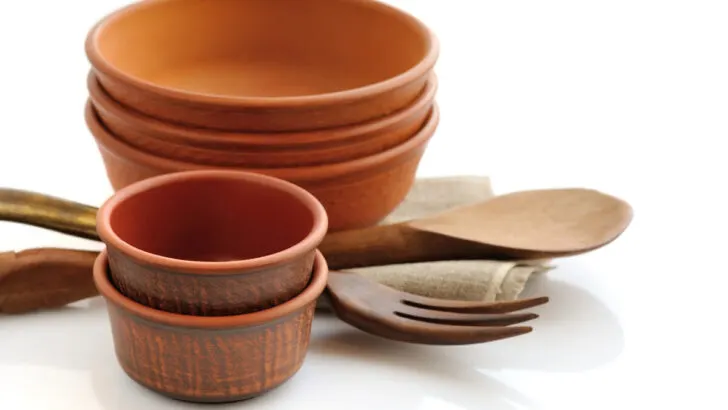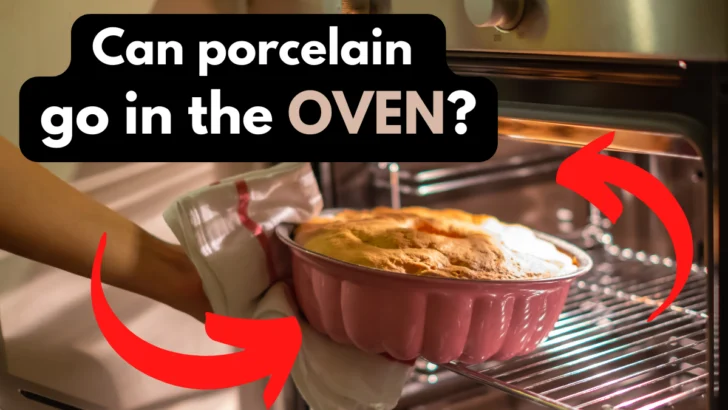Are you ready to bake a casserole for a perfect family dinner but you’re not sure if your porcelain can go in the oven? Then let me tell you, it can!
Porcelain can function effectively as ovenware and is safe to put in the oven. Usually, porcelain ovenware is safe for temperatures between 500 to 572 °F (260-300C).
If you are still not sure about your dish, then let’s dive into some details.
Is It Safe To Put Porcelain In The Oven?
For ceramics and pottery, three basic types of clay are used. They are made of porcelain, earthenware, and stoneware.
When ovenware is created, it is kiln fired. It is baked at extremely high temperatures in a kiln during the firing process. To put it simply, a kiln is an oven-like insulated heating chamber capable of much greater temperatures.
Among the three ceramic clays, porcelain is the one that is typically burned at the greatest temperatures. Porcelain is often fired at temperatures of 2372°F or higher (1300C).
Usually, porcelain ovenware is safe for temperatures between 500 to 572 °F (260 to 300C).
Each manufacturer will have a different range of maximum temperatures that their ceramic products can withstand. It is preferable to refer to the user manual or manufacturer’s website.
Instead of being made entirely of solid porcelain, some ovenware has a porcelain enamel coating. As an illustration, consider a “cast-iron casserole dish” with a porcelain coating.
Up to 400F, some porcelain-enameled plates can be used in the oven (204C). And some people can withstand temperatures of up to 500F. (260C).
Once more, it is preferable to refer to the user guide for the brand of your choice.
Why Is Porcelain Good Ovenware?
Here are some reasons which make a porcelain oven safe.
Porcelain Is Durable
Porcelain’s strength and durability make it a suitable contender for ovenware, which is another quality it possesses.
Because porcelain is constructed of materials with refined grains, a porcelain finish appears elegant. Furthermore, porcelain is frequently created from pure, impurity-free kaolin clay. Because of this, porcelain typically has a gorgeous white hue.
Porcelain can appear smooth, elegant, and white, which can give it a delicate aspect.
This appearance is misleading, though. In reality, porcelain is a solid, dense substance. Because of this, it makes a strong option for use as ovenware.
It can withstand the bumps that occur when being placed in and removed from the oven thanks to its robust construction.
When porcelain is manufactured, a process known as vitrification takes place that contributes to its strength. Feldspars are, as was already said, one of the main components of porcelain.
These are minerals that become a glassy liquid when heated. The glassy liquid fills clay particle pores. After being fired, the glass solidifies in the dish, becoming a highly hard, dense substance.
Porcelain bowls are thus vitreous. They are vitrified, which is another word for this. This means they are impermeable and solid in the real world.
Some other ceramic items, however, are not vitrified. Terracotta or other earthenware pottery is an illustration of this.
Ceramic Is Not Porous
As was already mentioned, porcelain also has the benefit of being non-porous. When porcelain undergoes the vitrification process, the spaces between the clay particles are filled with glass.
Pottery intended for use in ovens is typically glazed. This indicates that it is covered in a glass-like substance that deters liquid. Porcelain does not require glazing to make it waterproof because it has no pores.
However, it will typically be glazed. As a result, the surface has a high sheen and is stain, odor, and bacterial-resistant. Cleaning it is also simple.

How Can You Tell If Porcelain Is Oven Safe?
Dishes made of porcelain that have been specifically designed, produced, and marketed for use in the oven are considered oven-safe.
On the other hand, it’s possible that other kinds of porcelain won’t hold up well in the heat of the oven. Dishes that are more decorative rather than utilitarian, particularly if it was manufactured before the 1970s, is generally not safe to use in the oven.
There are several explanations for this phenomenon.
Imagine that you are shopping at a thrift store and you come across a stunning porcelain dish. The handles are intricately carved and delicately crafted, and the design is painted in a variety of colors, maybe including some paint in a gold tint.
Why is it best to assume that this meal cannot be cooked in the oven? Let’s check out some causes for worry…
Considerations For Safety
- If it is going to be used as ovenware, porcelain, which has a more polished appearance than other clays, needs to have a robust construction
- Handles and knobs on libs tend to be spindly and delicate, putting them at risk of shattering. This is especially true when the food is being cooked into the porcelain while adding more weight
- Hairline cracks are sometimes invisible flaws in vintage or pre-owned ceramics. If food becomes stuck in a crevice that is only a few hundredths of an inch wide, it can become fertile ground for the growth of bacteria
- Porcelain is susceptible to developing fine hairline fractures over time, which will cause the dish to become increasingly fragile. Over time, a little fracture might widen due to repeated stresses including heating, cooling, and washing
- There is also the problem of leaching, which means that older porcelain that has been cracked or chipped should not be used in the oven
- Metals are sometimes used in the glaze that is used to cover pottery, giving it an attractively bright and watertight glassy surface. Metals like copper, lithium, and cobalt can be found in certain glazes
- Glaze metals can leach into whatever is being cooked or served in the ceramic vessel. If the glazing is broken up or chipped, there is a greater possibility that leaching may take place.
Details About Leaching
Even when there isn’t any indication that the glaze has been damaged, leaching can still happen. Lead use in ceramic glaze has been a particular source of worry for the pottery industry.
Children who have lead in their bloodstream may experience nerve damage and developmental delays. A greater understanding of the perils of using lead in ceramic glaze emerged in the 1980s and 1990s.
Lead-containing glazes are now routinely labeled as “not food safe” in the trade. Additionally, commercial porcelain and ceramic producers will stress the absence of lead in their wares.
However, before people realized the risks, many glazes did contain lead. The use of older vintage ceramics carries a danger of leaching because of this.

It’s also important to think about the country of origin for the porcelain ovenware. The majority of ceramics made today for retail sales are regulated and must adhere to safety standards.
However, ceramics imported from places with less regulation may not adhere to strict safety standards.
For instance, scientists discovered that ceramic pottery in Philadelphia’s Chinatown neighborhood had harmful amounts of lead. Additionally, it is well known that China and Mexico import ceramic pottery containing lead.
Final Words to Using Porcelain in the Oven
To sum up, porcelain is suitable to use in an oven. The high density and impermeability of porcelain make them ideal for use in the oven.
Still, if you are unsure whether or not it is safe to bake with, you can check the oven-safe mark at the bottom of your dish/pot. However, you should always double-check them since there are chances of cracking and leaching.


